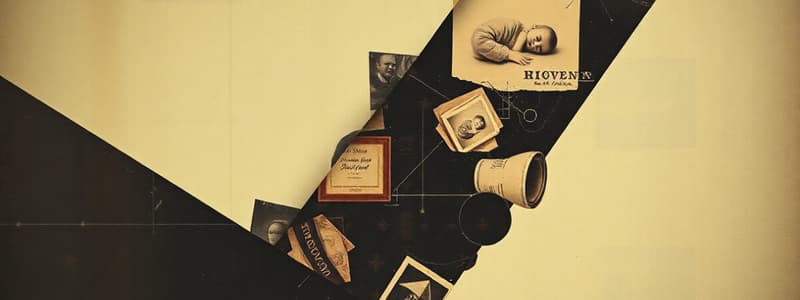Podcast
Questions and Answers
What condition is characterized by the inability to recognize objects despite having the ability to see them?
What condition is characterized by the inability to recognize objects despite having the ability to see them?
- Visual agnosia (correct)
- Sensory adaptation
- Difference threshold
- Absolute threshold
Which of the following best describes the relationship between sensation and perception?
Which of the following best describes the relationship between sensation and perception?
- Sensation interprets sensory input, while perception stimulates sense organs.
- Sensation and perception are independent processes that do not influence each other.
- Sensation refers to the stimulation of sense organs, and perception involves the interpretation of that sensory input. (correct)
- Perception occurs first, providing the raw data for sensation to process.
What is the focus of study in psychophysics?
What is the focus of study in psychophysics?
- The translation of psychological experience into physical stimuli.
- The measurement of absolute thresholds in different sensory systems.
- The effect of psychological experience on physical stimuli.
- How physical stimuli are translated into psychological experience. (correct)
Which concept is Gustav Fechner primarily associated with in the field of sensation and perception?
Which concept is Gustav Fechner primarily associated with in the field of sensation and perception?
What defines the absolute threshold for a sensory input?
What defines the absolute threshold for a sensory input?
Under what condition is the weakest amount of a stimulus considered to be at the absolute threshold?
Under what condition is the weakest amount of a stimulus considered to be at the absolute threshold?
What is the approximate absolute threshold for vision?
What is the approximate absolute threshold for vision?
What defines the difference threshold?
What defines the difference threshold?
What percentage difference in intensity is required for a person to notice a change in light, according to Weber's constant?
What percentage difference in intensity is required for a person to notice a change in light, according to Weber's constant?
What phenomenon explains why you eventually stop noticing a constant smell in a room?
What phenomenon explains why you eventually stop noticing a constant smell in a room?
Which structure of the eye does light first enter through?
Which structure of the eye does light first enter through?
Which of the following describes the function of accommodation in the eye?
Which of the following describes the function of accommodation in the eye?
What is the primary characteristic of nearsightedness?
What is the primary characteristic of nearsightedness?
What part of the eye adjusts to regulate the amount of light that enters?
What part of the eye adjusts to regulate the amount of light that enters?
What is the function of the retina?
What is the function of the retina?
What is the optic disk?
What is the optic disk?
What is the primary function of rods in the retina?
What is the primary function of rods in the retina?
Where is the fovea located, and what is its significance?
Where is the fovea located, and what is its significance?
What happens to the eyes during dark adaptation?
What happens to the eyes during dark adaptation?
Which Gestalt principle suggests that elements near each other are perceived as a group?
Which Gestalt principle suggests that elements near each other are perceived as a group?
How does the Gestalt principle of closure influence perception?
How does the Gestalt principle of closure influence perception?
Which Gestalt principle is exemplified when we organize forms in the simplest way possible?
Which Gestalt principle is exemplified when we organize forms in the simplest way possible?
How does linear perspective contribute to depth perception?
How does linear perspective contribute to depth perception?
What is the role of texture gradient in depth perception?
What is the role of texture gradient in depth perception?
How does relative size function as a depth cue?
How does relative size function as a depth cue?
How does height in plane contribute to depth perception?
How does height in plane contribute to depth perception?
What role do light and shadow play in depth perception?
What role do light and shadow play in depth perception?
How does interposition contribute to depth perception in visual processing?
How does interposition contribute to depth perception in visual processing?
Which of the following best describes the Phi phenomenon's contribution to visual perception?
Which of the following best describes the Phi phenomenon's contribution to visual perception?
In the context of visual perception, what defines the ‘figure’ in the ‘figure and ground’ principle?
In the context of visual perception, what defines the ‘figure’ in the ‘figure and ground’ principle?
An artist uses smaller brushstrokes to represent trees in the distance and larger, more detailed strokes for nearby trees. What depth cue is being utilized?
An artist uses smaller brushstrokes to represent trees in the distance and larger, more detailed strokes for nearby trees. What depth cue is being utilized?
A movie scene shows a long hallway where the walls and ceiling seem to converge at a point in the distance, giving the viewer a strong sense of depth. Which depth cue is most prominently used?
A movie scene shows a long hallway where the walls and ceiling seem to converge at a point in the distance, giving the viewer a strong sense of depth. Which depth cue is most prominently used?
During a magic show, the magician makes a volunteer appear to float by strategically placing them higher up on the stage relative to other objects. Which depth cue is the magician utilizing?
During a magic show, the magician makes a volunteer appear to float by strategically placing them higher up on the stage relative to other objects. Which depth cue is the magician utilizing?
In an advertisement, one product is intentionally placed partially in front of another. Which depth cue is being used?
In an advertisement, one product is intentionally placed partially in front of another. Which depth cue is being used?
Flashcards
What is psychophysics?
What is psychophysics?
The study of how physical stimuli are translated into psychological experience.
What is absolute threshold?
What is absolute threshold?
The minimum stimulus intensity that an organism can detect, detected 50% of the time.
What is difference threshold?
What is difference threshold?
Minimum difference in magnitude of two stimuli required to tell them apart, detected 50% of the time.
What is sensory adaptation?
What is sensory adaptation?
Signup and view all the flashcards
What is the cornea?
What is the cornea?
Signup and view all the flashcards
What is the lens?
What is the lens?
Signup and view all the flashcards
What is Accommodation in the eye?
What is Accommodation in the eye?
Signup and view all the flashcards
What is nearsightedness?
What is nearsightedness?
Signup and view all the flashcards
What is a cataract?
What is a cataract?
Signup and view all the flashcards
What is the pupil?
What is the pupil?
Signup and view all the flashcards
What does the pupil do?
What does the pupil do?
Signup and view all the flashcards
What is the retina?
What is the retina?
Signup and view all the flashcards
What is the optic disk?
What is the optic disk?
Signup and view all the flashcards
What are rods?
What are rods?
Signup and view all the flashcards
What are cones?
What are cones?
Signup and view all the flashcards
What is the fovea?
What is the fovea?
Signup and view all the flashcards
What is dark adaptation?
What is dark adaptation?
Signup and view all the flashcards
What is light adaptation?
What is light adaptation?
Signup and view all the flashcards
What is Phi phenomenon?
What is Phi phenomenon?
Signup and view all the flashcards
What is Figure and ground?
What is Figure and ground?
Signup and view all the flashcards
What is proximity?
What is proximity?
Signup and view all the flashcards
What is Similarity?
What is Similarity?
Signup and view all the flashcards
What is Continuity?
What is Continuity?
Signup and view all the flashcards
What is Simplicity?
What is Simplicity?
Signup and view all the flashcards
What is Closure?
What is Closure?
Signup and view all the flashcards
What are Pictorial depth cues?
What are Pictorial depth cues?
Signup and view all the flashcards
What is linear perspective?
What is linear perspective?
Signup and view all the flashcards
What is Texture gradient?
What is Texture gradient?
Signup and view all the flashcards
What is Relative size?
What is Relative size?
Signup and view all the flashcards
What is Height in planes?
What is Height in planes?
Signup and view all the flashcards
What is interposition?
What is interposition?
Signup and view all the flashcards
Study Notes
- Sensation and perception are related processes
Sensation
- The stimulation of sense organs
- Picking up raw information from the eyes, ears, nose, tongue, and skin
Perception
- Selection, organization, and interpretation of sensory input
- Understanding what that information means
Visual Agnosia
- A condition where individuals with perfect vision are unable to recognize or identify objects
Psychophysics
- Study of how physical stimuli translate into psychological experience
- Gustav Fechner was an important contributor to the field
Sensation
- Begins with a stimulus, or any detectable input from the environment
- Detectability depends on the perceiver
Absolute Threshold
- The minimum stimulus intensity an organism can detect for a specific type of sensory input
- Defines the boundaries of an organism's sensory capabilities
- It is the Weakest amount of a stimulus that can be distinguished from no stimulus at all
- Detected 50% of the time
Difference Threshold
- Minimum difference in magnitude between two stimuli required to tell them apart
- Detected 50% of the time
- Weber’s constant is a standard of difference, where:
- Light needs a 2% change in intensity
- Weight needs a 2% change in weight
- Sound needs a one-third of 1% change in pitch (frequency)
- Taste needs a 20% difference in saltiness
Sensory Adaptation
- Gradual decline in sensitivity to prolonged stimulation
- Stimulus intensity remains stable, but sensitivity decreases with continued exposure
The Eye
- Light enters through the cornea, a transparent window
- The cornea and lens form an upside-down image on the retina
- The lens is a transparent structure made of soft tissue, allowing adjustment called accommodation -Accommodation allows the curvature of the lens to adjust and alter visual focus
- Cataract: clouding of the lens
- Pupil: opening in the center of the iris, regulating light amount
- Constricts to block too much light and dilates in low light conditions
- Retina: neural tissue lining the inside back surface
- Absorbs light, processes images, and sends information to the brain
- Images on the retina are upside down
- Nearsightedness: close objects are clear, distant ones blurry
- Farsightedness: distant objects are clear, close ones blurry
- Optic disk: axons leaving the retina converge, creating a blind spot in the retina
- The image when falls onto the hole cannot be seen
- It absorbs light, processes images and sends visual information to the brain
Visual Receptors
- Rods: specialized for night and peripheral vision
- Rods are elongated and outnumber cones
- Cones: specialized for daylight vision and color
- Cones are stubbier then rods
- Fovea: tiny spot in the center of the retina, containing only cones
Dark and Light Adaptations
- Dark adaptation: eyes become more sensitive to light in low illumination
- Occurs when entering a cinema from a bright environment
- Light adaptation: eyes become less sensitive to light in high illumination
- Occurs when returning outdoors from a dark cinema
Gestalt Principles of Visual Perception
- Phi Phenomenon: Illusion of movement shown by visual stimuli in quick succession
- Figure and Ground: Organizes visual perception; the figure is the focus and the ground is the background
- Proximity (Closeness): Elements near each other are grouped together
- Similarity: Grouping stimuli that are together.
- Continuity: Tendency to follow in whatever direction elements lead
- Simplicity: Forms are organized in the simplest way possible
- Closure: Missing pieces are added to complete familiar figures
Pictorial Depth Cues
- Cues about distance that can be given in a flat picture
- Linear perspective: Depth cue reflecting lines converging in the distance
- Texture gradient: Texture is coarse for near areas and finer for more distant areas
- Relative size: Closer objects appear larger
- Height in planes: Distant objects appear higher in an image
- Light and Shadow: Creates an impression of three-dimensional forms
- Interposition: Near objects overlap or mask more distant ones
Studying That Suits You
Use AI to generate personalized quizzes and flashcards to suit your learning preferences.




